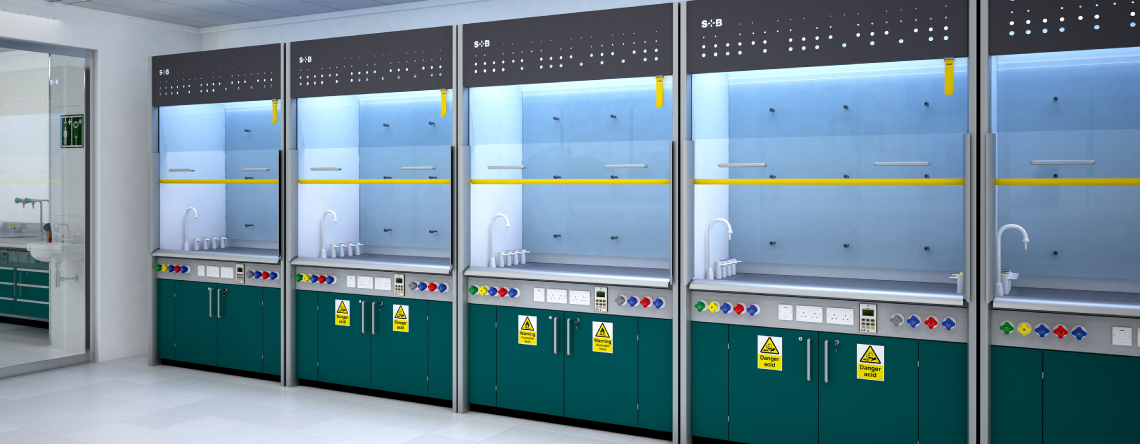Fume Cupboards and Bio Safety Cabinets look very similar and come in a range of similar sizes. Both are designed to provide levels of protection from hazardous materials particularly against inhalation of harmful fumes by scientists, researchers, technicians, teacher`s and students working in laboratories.
Fume Cupboards vented to atmosphere by means of a fan and ductwork fume extraction system.
A fume cupboard is a partial enclosure which is connected to a fan and ductwork fume extraction system. The cupboard is designed to protect the operator from inhalation of chemical fumes and aerosols generated by the work being carried out. Air is drawn from the room and away from the area of the operator into the chamber usually via a vertical or horizontal sliding sash/window. The air volume dilutes the fumes when being pulled through the chamber and discharges externally to atmosphere where fumes are further diluted.
Some fume cupboards maybe fitted with some form of filtration, water or chemical scrubber systems in order to decontaminate the fumes prior to discharge, although this will only be applied in very particular circumstances, the norm being the absence of any fume capture or cleaning system.
Relevant internationally recognised and accepted standards are EN14175 and ASHRAE 110-2016.
Re-circulatory filtration Fume Cupboards.
The re-circulatory fume cupboards type is used for many of the same applications and operates in a similar way by means of a fan drawing air through the room and away from the operator. The difference is that the fan is integral to the unit and the air does not discharge externally to atmosphere, but via an activated carbon filter which decontaminates the fumes before discharging the air back into the room.
Relevant standards – BS7989 and ANSI/ASHRAE STANDARD 62.1-2020
Biological Safety Cabinets
Biological Safety Cabinets provide protection for the operator and additionally where required for the material/component being worked on as well as the environment. Operators are protected from infectious substances, biological hazards and aerosols generated by work being undertaken. The use of integral HEPA filters which cleanses air on entry to the chamber is the means by which protection for operator, work piece and environment is enabled. Biological Safety Cabinets can be and sometimes are connected to fan and ductwork fume extraction systems which discharge decontaminated air externally to atmosphere.
There are three principal Classes of Bio Safety Cabinet:
Class 1
Air is drawn from the room, horizontally across the work surface and away from the operator. The air passes through a front opening sash/window/hatch and into the chamber. This Class protects the operator but not the work piece.
Class 2
Air is drawn from the room, away from the operator and flows downward to the work surface, passing through a HEPA filter before being recirculated back into the room or discharged externally to atmosphere. This Class also has front opening operator access and provides protection for operator, work piece and environment.
Class 3
Class 3 are sealed enclosures with intake and exhaust air passing through HEPA filters.
Relevant standards – NSF/ANSI STANDARD 49 and EN12469
Note – care should be taken to ensure the choice of cabinet provides containment values consistent with the Bio Safety level required.
Laminar Flow Cabinets
These units are similar in appearance and size range to Fume Cupboards and Bio Safety Cabinets. They are designed to provide protection to the workpiece by passing a filtered curtain of air across the work area. This cabinet does not provide protection for the user or the environment, so should only be use for non-hazardous applications.
There is a great deal more to this subject matter than can be covered in a brief overview document like this.
As with all potentially hazardous work being undertaken, Risk Assessment is an essential component in product selection and process. Applications must be thoroughly understood and risk levels properly assessed before selecting and then using a product. Whenever in any doubt, expert advice should be sought. The standards referenced are a good starting point and many specialist manufacturers can provide expert support. Always take care to ensure that whenever a standard is referenced in support of a product or service, there is independent certification which confirms full compliance with that standard.

